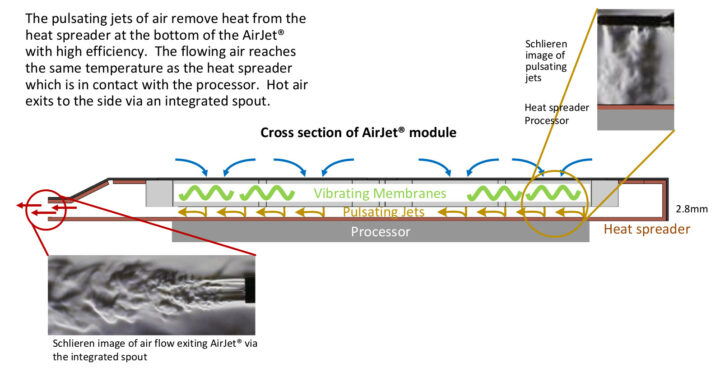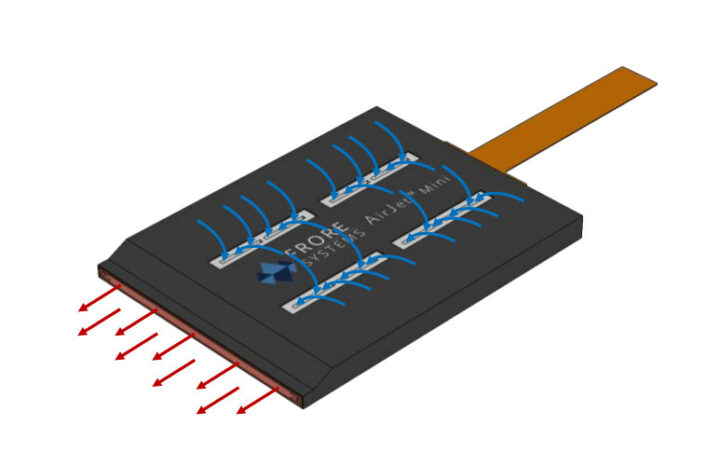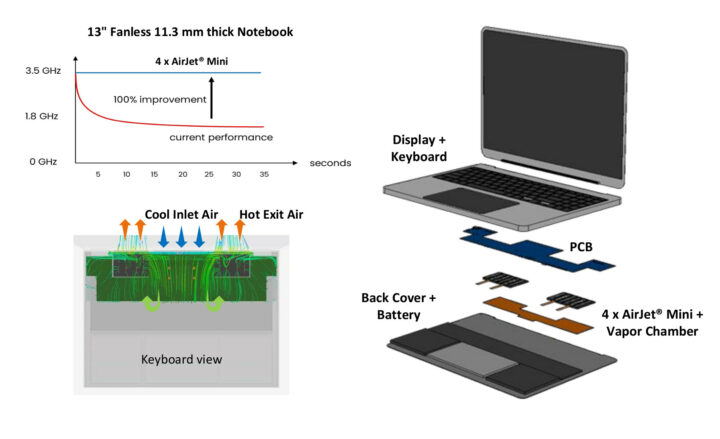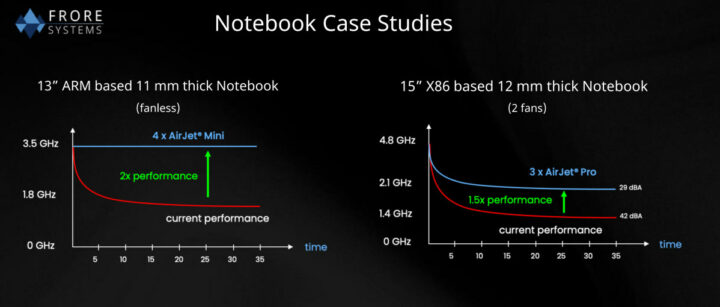Frore Systems Airjet Mini and Airjet Pro are active cooling chips that are just 2.8mm thick and quietly suck cool air in from the top of the chip before pushing it out the sides with the aim to replace traditional fan-based solutions in ultrabooks, or be integrated into VR headsets and smartphones for improved cooling.
Yesterday we saw that cameras could clean themselves with micro-vibrations, and it happens that processors can be cooled with vibrations too as the Airjet chips are comprised of tiny membranes that vibrate at ultrasonic frequencies to generate a flow of air that enters through inlet vents in the top and transformed into high-velocity pulsating jets exiting from one side of the chip.
 The AirJet module is actually not placed directly on the processor in ultrabooks but on copper pipes because it allows for thinner designs that way. The company says the AirJet Mini and Pro modules outperform cooling fans as they generate a much higher back pressure of up to 1750 Pa against just 195 Pa for a typical laptop fan, and operate silently at 21 dBA, while fans are noisier at around 42 dBA. The Mini can dissipate up to 5 Watts of heat, while the larger Pro models can dissipate up to 10 Watts.
The AirJet module is actually not placed directly on the processor in ultrabooks but on copper pipes because it allows for thinner designs that way. The company says the AirJet Mini and Pro modules outperform cooling fans as they generate a much higher back pressure of up to 1750 Pa against just 195 Pa for a typical laptop fan, and operate silently at 21 dBA, while fans are noisier at around 42 dBA. The Mini can dissipate up to 5 Watts of heat, while the larger Pro models can dissipate up to 10 Watts.
The solution can lead to increased performance in space-constrained applications as modern processors have turbo or peak performance modes that can only last a short time due to thermal constraints. With a solid-state cooling solution is possible to extend that time or, in the case of Arm processors, operate at peak performance continuously, leading to significant performance improvements. Frore Systems claims to have practically doubled the performance of a passively-cooled 11.3mm thick Arm netbook with four AirJet Mini modules mounted to a vapor chamber since the processor could run at 3.5 GHz continuously, instead of falling back to 1.8 GHz with the fanless solution.
Doing the same with a fan-cooled Intel-based laptop and three AirJet Pro modules also improved the performance, but the system could not run at Turbo frequencies at all times.
The power consumption of the AirJet Mini is 1W, so roughly equivalent to a small 5V fan, and that converts into up to 4W of power consumption for the Arm laptop prototype above just for the cooling solution. It measures 27.5 x 41.5 x 2.8 mm and weighs 11 grams. The company has yet to announce pricing, but I would guess it’s only suitable for higher-end products at this time since they told PCMag that “we’re competitive relative to the value that we’re delivering”.
We’ll find out about pricing and how well it works soon enough since Frore Systems is currently collaborating with Intel and Intel laptop manufacturers with AirJet-cooled laptops expected later in 2023. Depending on the price, I could see it replacing many actively cooled solutions for systems with up to 28W processors, as well as being implemented into ultrathin designs for improved performance, but it might not be found in thicker fanless designs due to the additional power consumption and costs. Additional information may be found on the company’s website.
Thanks to Anonymous for the tip.

Jean-Luc started CNX Software in 2010 as a part-time endeavor, before quitting his job as a software engineering manager, and starting to write daily news, and reviews full time later in 2011.
Support CNX Software! Donate via cryptocurrencies, become a Patron on Patreon, or purchase goods on Amazon or Aliexpress







